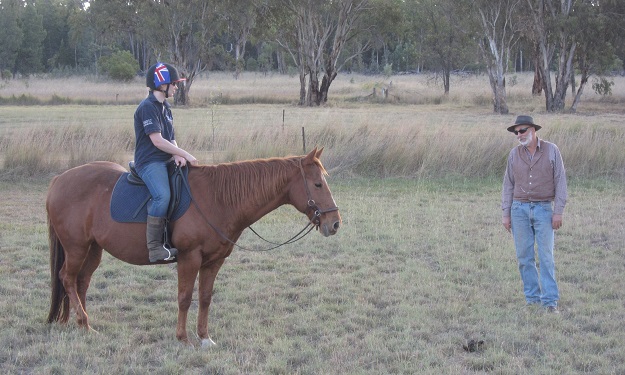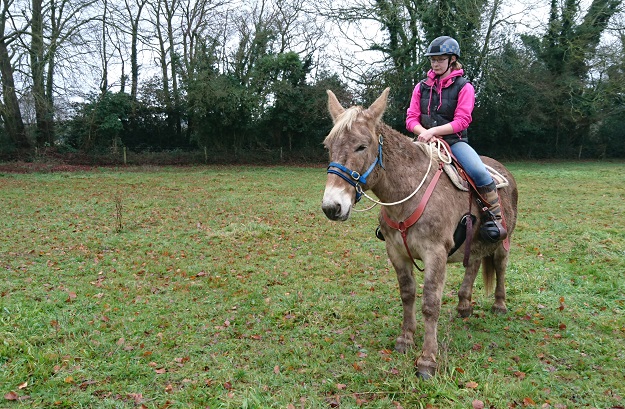Five years ago, Ben hosted a UK clinic for an Australian trainer called Ross Jacobs. I had only recently started dating Ben, although I’d known him for years, and so had only recently been introduced to this thing called horsemanship. It seemed a bit wack to me but I was rather keen on Ben, so I tried my best to understand the thing he was most passionate about. I spectated at a two-day clinic in Hampshire and went away feeling like I understood it: or rather, I understood what I wanted to understand, and disregarded the rest.
The following year Ben and I went to Australia and spent the better part of a week staying with Ross and his wife, Michèle. We rode every day, generously tutored by Ross. It was during this week that I began to have an uncomfortable metamorphosis.
I started to realise that the thing I thought I was good at – horses – was not a thing I was good at at all. This was quite an alarming notion and I did a very good job at shutting down and vehemently denying it to myself. What was this bloke on about? Why did it matter if I led a horse in with a tight rope or a loose rope? I still got them from A to B! The outcome was still the same! I didn’t have time to correct every little thing.
And so the week ended and I, fuming, indignant, went home.

Fortunately for me, Ross’ teachings had managed to lodge themselves in my brain and, over the following year, they began to filter through. I had moved down south and was looking after Ben’s horses quite a bit, and I also picked up a groom job at an eventing yard. Slowly but surely, I began to realise how much nicer it was to handle a horse who was tuned in to what I was doing and asking.
My expectation of what was ‘normal’ began to shift. The event horses, although diligently schooled under saddle by their owners every day, did not have the same feel to them as Ben’s did. Ben’s horses were not perfect – no horse is – but if things went awry, it was a bump in the track rather than a full-on derailment. It was easier and quicker to get the wheels turning again. The groundwork which I had previously seen as pointless suddenly made a lot of sense.
And then when I got Marty, it really began to make sense. This mule was not as willing to fill in for my inadequacies as all the horses had been! I remember telling Anna, who was surprised to hear how new I was to all this, that my conversion was due to Ross Jacobs and a mule.
When I first got Xato, I wrote about my intention to take him bitless. This decision was initiated by the fact that he has a very fleshy tongue, and so is only comfortable in a skinny bit; I felt he would be even more comfortable if he didn’t wear a bit at all. I had no real opinion about bits vs. bitless other than, for my guy, I felt the latter would be his best option.

All the ridden work we’ve done so far has been in his Dually (I am saving up to get him a proper sidepull – it will have to be custom made to fit that gigantic head!). Although he was improving steadily every session, I began to doubt my bitless plans. He never did anything dramatic but sometimes he would just set his neck and bolt with me in walk. I was desperate to start hacking out, but it seemed like a painfully long distance to get from where we were to riding safely across the wide open … and so I began to wonder about putting a bit in.
I have a bit for him, a PeeWee, which is designed for fat-tongued equines and which he seemed comfortable to hold in his mouth. I have never used it other than to try it on for size, but Evil Sari came and sat on my shoulder and whispered that, maybe, if I switched to it, I could start riding out much sooner.
Luckily, common sense won through and pointed out that if I couldn’t consistently get him to bend smoothly and stop when asked while bitless, then although putting a bit in would get a response, I wouldn’t actually be communicating with him; I felt I would be forcing a change, rather than asking. It seemed to me that if the foundation wasn’t sound, then problems were more likely to arise and all I would be doing was putting myself on the slippery slope towards stronger and stronger bits.
So then I thought: maybe if I keep working at it until he’s going well, and then I can put a bit in and go out for a ride.
And then I thought: but if I can put the work in and get him to do the minimum he needs for me to feel like I can ride him out, why can’t I just put more work in until he’s safe to ride out bitless as well? Any equine can go bitless providing the foundation is there, right?
Which created my final thought: if that’s the case, why would a bit ever be needed?
I asked Ben about this several times but just didn’t feel like the answer was watertight; I could still pick holes in it. I mentioned, in passing, that it was the kind of thing I’d like to ask Ross. Ben said I should, but I deliberated and procrastinated and drafted a couple of emails before realising what my problem was: I was hugely embarrassed and ashamed of that week four years ago. At the time I had no idea what an incredible opportunity I had, and I have kicked myself countless times since then.
So I opened up Gmail, started a new letter, and told Ross how very sorry I was for being such a plonker and could he please help me with a question that had been bugging me.
Ross was very kind and said that I wasn’t the most resistant person he’d taught, which was a much bigger compliment than I deserved. He also wrote a brilliant reply to my question about bits and said that I could share it on here, which is really the whole point for this terribly long post: I felt that I needed to share the backstory to go with it. During Marty’s more difficult moments I would say that I hoped this blog helped people feel better about themselves because at least they weren’t as bad as me, and I guess I can continue that trend!
Ross’ reply:
With regard to bits, I don’t consider them ever necessary. But I do think they offer some advantage.
Firstly, a bit is nothing more than something to attach the reins to. It is the reins that convey the message from the rider to the horse and if the reins are attached to a bit or a noseband the message remains the same. For this reason I do consider that if a horse responds to a bit but does not respond just as well without a bit, there is a problem in the way the horse understands the message coming down the reins. This needs to be fixed. If you require a bit to evoke a change of thought then you are relying on pain to create the change of thought. In theory, this should not be because the essential difference between the bit and the noseband is the ability of the bit to exert more force/pain.
I have done a lot of riding in halters and side pulls – including re-training bolters and buckers – and never needed to re-educate a horse to the feel of a snaffle bit once the horse gets the idea of giving to the reins. The opposite is equally true. When swapping from riding with a bit to a side pull I just change the head gear and go on. It’s always been seamless. Not once have I ever needed to break the horse into a side pull. But it requires the horse is listening well to the reins first irrespective of what the reins are attached to. There are people in Australia holding bitless riding clinics for people who want to transition from a bit to bitless and I don’t understand why they need a clinic to do this. I should consider doing this type of clinic because it would be the easiest money I ever made.
The issue of why ride with a bit is one I get asked quite a lot. There is nothing that you can do when riding with a bit that you can’t do without a bit. So for most people bits are unnecessary. However, the thing that a bit does do is add refinement. Equipment like halters, side pulls, bosals etc have a lot of slop in them. Much of the energy that travels down the reins gets absorbed by the material and the slop and is lost without giving meaning to the horse. Imagine two people holding a rope – one at each end. One person taps their end of the rope with their finger and the other person tries to feel the tapping. Now substitute the rope for a metal bar. You’ll find the person can detect a lot smaller/gentler tap when the bar is used compared to when the rope is used because there is less energy lost with something so rigid as a metal bar. The same is true with a bit. A well made and fitted bit allows more accurate transmission of the feel (energy) of the reins than say a side pull.This means a person can do less with the reins and get more when a bit is used than when a side pull is fitted. A horse is just more sensitive to the use of a bit than to a side pull. It doesn’t mean one is better than the other or one allows you to do different things than the other. It just means a bit allows a rider the opportunity to be more refined and quieter with the reins and get the same result.
It’s a lot like using spurs. Spurs don’t do anything that a rider can’t do without spurs. But spurs allow a rider to apply less leg and get the same result.
I believe every horse should be able to be ridden with or without a bit just fine. I’m not so fussed that a horse be taken to the level of being ridden in a cathedral bit. In fact, I think the whole ‘bridle horse’ thing is a crock of shit. I believe the same thing about double bridles too – no need for them, should be banned. But those are topics for another time. In any case, every horse or mule should go well in a bitless device or a snaffle bit.
I should say before finishing that just like bits, not all bitless head gear are created equal. There are good designs and bad ones. The reason I like a soft leather side pull is because it comes closest to mimicking how a snaffle works. But that’s my personal preference.
Ross is the author of The Essence of Good Horsemanship, Old Men And Horses and Changing The Tide – all of which can be purchased here. He writes extensively on his Facebook page, Good Horsemanship – Ross Jacobs, and you can check out his website for more articles and information on his clinic schedule.

My horses (before I got into mules) were all broken on a snaffle and ridden for at least 3-4 years on a bit before getting to bitless…. I tend to do the same thing with the 4 mules….all mules (aged 5-9) now do their job on a bit, only when they know everything they need I will put them on a dr cook ( I do not like sidepulls at all)…..
But I do not agree that every horse ridden on a bit can go on a bitless bridle just like that, with some horses it takes a long time and with some you don’t get there….. I also am convinced that whatever you do or do not put in a horses mouth it is allways the riders hand that makes the difference…..wow, I am absolutly not pro or contra any type of bridle….
Of course, I am not a horse trainer, nor whisperer and don’t give clinics, but I ride for allmost 35 years now and we broke allmost all of our horses ourselves…..
What don’t you like about sidepulls? I’m completely the opposite – I like sidepulls because I think they are the simplest bitless bridle and therefore offer the most clarity, whereas the cross-under style of the Dr Cook doesn’t seem to offer an instant release which I think can be quite confusing to a horse/mule.
I don’t think Ross is saying every horse *can* go from bitted to bitless without issue, I think he’s saying that they *should* be able to. If they can’t, then they don’t have a proper understanding of the reins.
Excellent! I have been a student of Harry Whitney for 14 years now, I understand your transformation! Thanks so much for sharing Ross’ reply. Ross’ latest book is going to become required reading for all my students, current and new! I very much enjoy your FB page and all your mule thoughts! Kathy Baker
Oh fantastic – my partner and I were able to ride on one of Harry’s clinics in Arizona just over a year ago, and that was a big turning point for me too. I started being able to understand a lot of what Ross had tried to teach me four years ago; and, equally, if I hadn’t had that time with Ross then I think I would have struggled more with Harry. Sometimes you need two puzzle pieces to fit together before you start to “get” it!
My experience is simple if my mule wants to run off she will do regardless of what is in her mouth , it’s up to me to train her not to .😊
The problem with sidepulls is that very few of them are made well enough not to have excessive “slop” when engaged. You engage the rein and the noseband rotates and pulls the cheekpiece with it. The best sidepulls have a triangular “brace” around the ring and an extra chin strap to keep the cheekpiece stable as on a (good) lungeing cavesson. I know some lungeing cavesson designs in europe offer rings that angle outward more to allow for proper rein attachment and the ability to use it as a riding cavesson.
I am personally not a fan of the Dr. Cook’s bridle and most of its iterations. The rein rings kill it for me and I believe they are a part of the release issue since the weight of the ring plus rein buckle (or, heaven forbid, a snap and buckle) keeps tension on the jaw straps. The one I do really like is made by a lady in Colorado through http://www.mossrockendurance.com I have a bridle of hers for each of my horses (one using her sidepull, the rest are Evolution bridles, she does custom sizes no extra charge).
That said I’ve been doing some bit experimenting and plan on continuing in the coming year. One of the experiments is the Stark Naked Bit (http://starknakedbits.com/home.html), which can be custom made in various widths and lengths. It’s a biothane jaw bit, though you can easily attach it to a normal bridle and leave the chin strap loose if desired. It is flat, which might be good for horse’s without a lot of room between their tongue and pallette. I believe they come in widths from 1/2″ up to 1″, but you would have to check with them on that. I need to play with them more, but it is the one bit my mouthy Arab doesn’t sit there and jaw incessantly.
I do like Ross’ analogy between the rope and the bar to compare bit and bitless. For me it boils down to what the equine goes best in. If it happens to be soft and light in a plain single joint loosering snaffle bit, great. If it prefers a sidepull, sure!